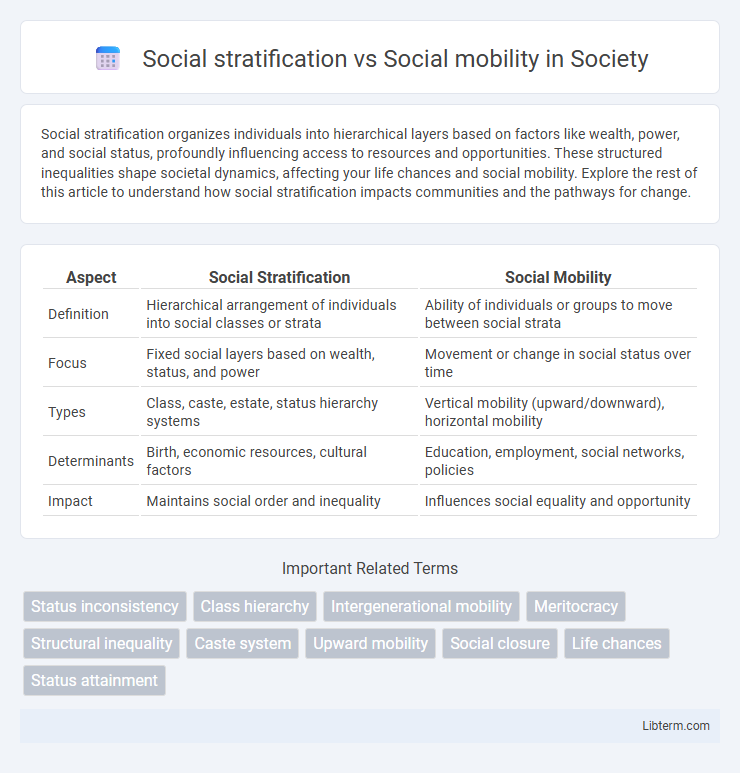Social stratification organizes individuals into hierarchical layers based on factors like wealth, power, and social status, profoundly influencing access to resources and opportunities. These structured inequalities shape societal dynamics, affecting your life chances and social mobility. Explore the rest of this article to understand how social stratification impacts communities and the pathways for change.
Table of Comparison
| Aspect | Social Stratification | Social Mobility |
|---|---|---|
| Definition | Hierarchical arrangement of individuals into social classes or strata | Ability of individuals or groups to move between social strata |
| Focus | Fixed social layers based on wealth, status, and power | Movement or change in social status over time |
| Types | Class, caste, estate, status hierarchy systems | Vertical mobility (upward/downward), horizontal mobility |
| Determinants | Birth, economic resources, cultural factors | Education, employment, social networks, policies |
| Impact | Maintains social order and inequality | Influences social equality and opportunity |
Introduction to Social Stratification and Social Mobility
Social stratification refers to the hierarchical arrangement of individuals in society based on factors such as wealth, power, and social status, which often leads to unequal access to resources and opportunities. Social mobility measures the ability of individuals or groups to move within this social hierarchy, either upward or downward, influenced by education, occupation, and economic factors. Understanding social stratification and social mobility is crucial for analyzing patterns of inequality and the potential for change within social structures.
Defining Social Stratification
Social stratification is the hierarchical arrangement of individuals into social classes, castes, or strata based on factors such as wealth, power, education, and occupation, which determine access to resources and opportunities. It establishes structured inequalities that shape individuals' life chances and social status within a society. This system creates layers of privilege and disadvantage, influencing social mobility, which refers to the ability to move between these social strata.
Understanding Social Mobility
Social mobility measures the ability of individuals or groups to move within a social hierarchy, contrasting with social stratification, which describes the structured layers of society based on factors like wealth, education, and occupation. Understanding social mobility involves analyzing intergenerational changes in income, education levels, and occupational status to assess equality of opportunity. High social mobility indicates a more fluid society where barriers to advancement are lower, while low mobility reflects rigid class structures and persistent inequality.
Types of Social Stratification Systems
Social stratification systems include caste, class, estate, and meritocracy, each defining hierarchy and status distribution uniquely across societies. Caste systems impose rigid, hereditary divisions with little to no mobility, whereas class systems offer more fluidity, allowing individuals to change their social position based on economic status and achievements. Estate systems combine legal and economic factors restricting social mobility, while meritocracies base stratification on individual talent and effort, promoting upward mobility through personal merit.
Factors Influencing Social Mobility
Social mobility is influenced by education level, economic resources, family background, and social networks, which determine an individual's ability to move within social strata. Structural factors such as labor market dynamics, government policies, and economic development also play a critical role in facilitating or hindering upward or downward social mobility. In contrast, social stratification remains stable when these factors limit access to opportunities, reinforcing existing class divisions and reducing overall mobility.
The Relationship Between Stratification and Mobility
Social stratification creates structured layers of social inequality that define individuals' access to resources, power, and status, influencing their social mobility opportunities. High levels of stratification tend to restrict social mobility by entrenching barriers based on class, race, and education, while more fluid stratification systems enable greater upward or downward movement within society. The dynamic interaction between stratification and mobility shapes societal stability, affecting economic growth and social cohesion.
Barriers to Social Mobility
Social stratification creates rigid hierarchies based on socioeconomic status, education, and occupation, which often result in significant barriers to social mobility. Structural obstacles such as unequal access to quality education, discriminatory hiring practices, and economic disparities prevent lower-income individuals from climbing the social ladder. These systemic barriers perpetuate inequality by limiting opportunities for upward movement across different social strata.
Social Stratification: Impacts on Society
Social stratification creates hierarchical layers in society based on factors such as wealth, education, and occupation, influencing access to resources and opportunities. It perpetuates inequality by limiting social mobility for lower strata, leading to disparities in health, education, and income. The rigid structure of social stratification impacts social cohesion, often resulting in social tension and reduced economic growth.
Case Studies: Social Mobility Across Various Societies
Case studies of social mobility across diverse societies reveal significant variations in the ability of individuals to change their social status, influenced by factors such as education, economic policies, and cultural norms. Research indicates that Nordic countries exhibit high social mobility due to robust welfare systems and equal opportunity frameworks, whereas societies with rigid caste systems or entrenched class hierarchies show limited upward mobility. These comparative analyses underscore the complex interplay between social stratification mechanisms and mobility patterns, highlighting the critical role of institutional structures in shaping individual life chances.
Conclusion: Addressing Social Inequality
Addressing social inequality requires dismantling barriers in social stratification that limit upward social mobility, such as unequal access to education and employment opportunities. Implementing policies that promote economic redistribution, affirmative action, and inclusive social programs can enhance social mobility and reduce entrenched disparities. Sustainable progress depends on recognizing the interconnectedness of social class structures and mobility mechanisms to create a more equitable society.
Social stratification Infographic

 libterm.com
libterm.com